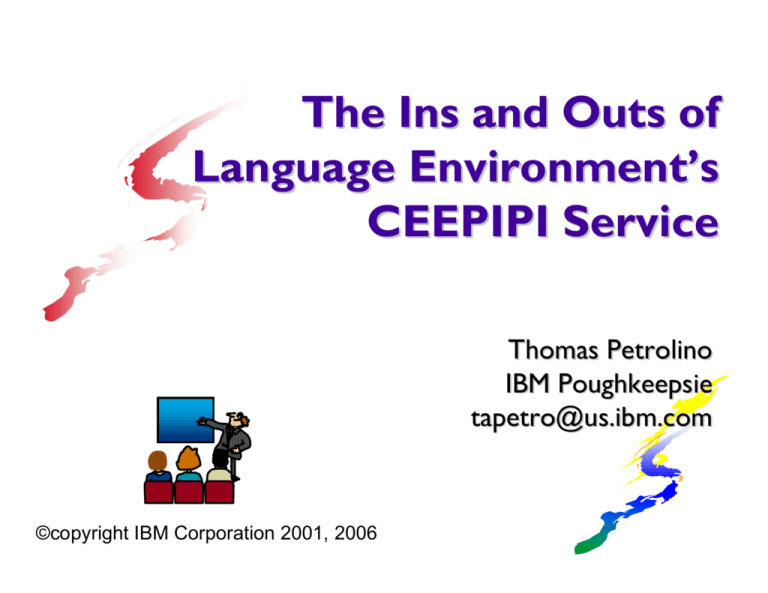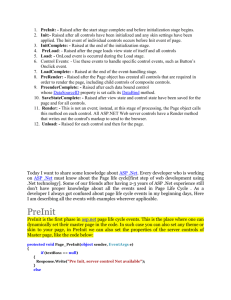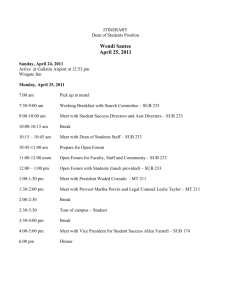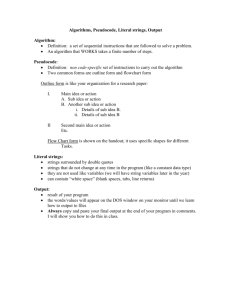The Ins and Outs of Language Environment's CEEPIPI Service
advertisement

The Ins and Outs of
Language Environment’s
CEEPIPI Service
Thomas Petrolino
IBM Poughkeepsie
tapetro@us.ibm.com
©copyright IBM Corporation 2001, 2006
Trademarks
The following are trademarks of the International Business Machines Corporation in the United States and/or other countries.
•CICS®
•DB2®
•Language Environment®
•OS/390®
•z/OS®
* Registered trademarks of IBM Corporation
The following are trademarks or registered trademarks of other companies.
Java and all Java-related trademarks and logos are trademarks of Sun Microsystems, Inc., in the United States and other countries.
Linux is a registered trademark of Linus Torvalds in the United States, other countries, or both.
Microsoft, Windows and Windows NT are registered trademarks of Microsoft Corporation.
UNIX is a registered trademark of The Open Group in the United States and other countries.
SET and Secure Electronic Transaction are trademarks owned by SET Secure Electronic Transaction LLC.
* All other products may be trademarks or registered trademarks of their respective companies.
Notes:
Performance is in Internal Throughput Rate (ITR) ratio based on measurements and projections using standard IBM benchmarks in a controlled environment. The actual throughput that any user will experience will vary depending
upon considerations such as the amount of multiprogramming in the user's job stream, the I/O configuration, the storage configuration, and the workload processed. Therefore, no assurance can be given that an individual user will
achieve throughput improvements equivalent to the performance ratios stated here.
IBM hardware products are manufactured from new parts, or new and serviceable used parts. Regardless, our warranty terms apply.
All customer examples cited or described in this presentation are presented as illustrations of the manner in which some customers have used IBM products and the results they may have achieved. Actual environmental costs and
performance characteristics will vary depending on individual customer configurations and conditions.
This publication was produced in the United States. IBM may not offer the products, services or features discussed in this document in other countries, and the information may be subject to change without notice. Consult your local
IBM business contact for information on the product or services available in your area.
All statements regarding IBM's future direction and intent are subject to change or withdrawal without notice, and represent goals and objectives only.
Information about non-IBM products is obtained from the manufacturers of those products or their published announcements. IBM has not tested those products and cannot confirm the performance, compatibility, or any other claims
related to non-IBM products. Questions on the capabilities of non-IBM products should be addressed to the suppliers of those products.
Prices subject to change without notice. Contact your IBM representative or Business Partner for the most current pricing in your geography.
2
Agenda
yUnderstanding
The Basics of PreInitialization
yUsing the Language Environment PreInitialization
Programming Interface (Preinit)
yPreinit Interfaces
yPreinit Service Routines
yA Preinit Example
ySources of Additional Information
3
Understanding The
Basics of
PreInitialization
Background - LE Init/Term
yProcess
- Collection of Resources
(LE message file, library code/data)
unaffected by HLL semantics, logically
independent address space
yEnclave
Process
Enclave
Thread
- Collection of Routines
(Load modules, Heap, external data)
defines scope of HLL semantics, first
routine is designated "main"
yThread - "thread" of execution (Stack,
raised conditions)
share the resources of the enclave
5
Understanding The Basics
yRead
Language Environment Programming Guide, Chapter 30
"Using preinitialization services" (SA22-7561)
yRead
Language Environment Programming Guide for 64-bit
Virtual Addressing Mode, Chapter 22 “Using preinitialization
services with AMODE 64” (SA22-7569)
6
Understanding The Basics…
yYou
can use preinitialization to enhance the performance of
certain applications
yPreinitialization
lets a non-LE-conforming application (eg.
Assembler) initialize an LE environment once, perform
multiple executions of LE-conforming programs using that
environment, and then explicitly terminate the LE environment
yBecause
the environment is initialized only once (even if you
perform multiple executions), you free up system resources
and allow for faster responses to your requests.
7
A non-Preinit scenario
non-LE-conforming
(LE not active)
Invoke A
LE-conforming
Initialize LE
Run A
Terminate LE
Invoke B
LE-conforming
Invoke C
LE-conforming
Initialize LE
Run B
Terminate LE
Initialize LE
Run C
Terminate LE
8
Same application using Preinit
non-LE-conforming
(LE not active)
LE Preinit Init
Invoke A
LE-conforming (Preinit environment)
Run specified program
Invoke B
Invoke C
LE Preinit Term
9
Older forms of preinitialization
yThe
following is a list of pre-LE language-specific forms of
preinitialization. These environments are supported by LE but
will not be enhanced.
C and PL/I -- supports prior form of C and PL/I preinitialization
(PICI) through use of Extended Parameter List
C++ -- no prior form of preinitialization
COBOL -- supports the prior form of COBOL preinitialization
through use of RTEREUS run-time option and ILBOSTP0 and
IGZERRE functions
Fortran -- no prior form of preinitialization
yLE
Library Routine Retention (LRR) is also supported but is
not the "preferred" method
10
Restrictions on pre-LE preinitialization
yPOSIX(ON)
yXPLINK
yAMODE
64
11
Users of preinitialization
Numerous IBM products currently utilize
preinitialization
•Program Management Binder – for C++
demangler
•DB2 – for stored procedures
•CICS – TS V3.1 for recently announced XPLink
support
•. . .
Many IBM customers…
12
Using the Language
Environment
PreInitialization
Programming
Interface (Preinit)
Using Preinit
yThe
main Preinit interface is the loadable module "CEEPIPI“
y The
AMODE 64 Preinit interface is the loadable module “CELQPIPI”
yCEEPIPI
handles the requests and provides services for:
LE Environment Initialization
Application Invocation
LE Environment Termination
yAll
requests for services by CEEPIPI must be made from a
non-Language Environment environment
yThe parameter list for CEEPIPI is an OS standard linkage
parameter list
First parameter on each call to CEEPIPI is a Preinit function code
14
The Preinit table
yThe
Preinit table identifies routines to be executed (and
optionally loaded) in a Preinit environment
It contains routine names and/or entry point addresses
It is possible to have an "empty" Preinit table with empty rows
yroutines can be added later using the Preinit add_entry interface
yIn
the Preinit table, entry point addresses are maintained
with the High Order Bit set to indicate AMODE of routine
HOB on, routine is AMODE31 and invoked in 31 bit mode
HOB off, routine is AMODE24 and invoked in 24 bit mode
yCEEBXITA
(Asm User Exit), CEEBINT (HLL User Exit),
CEEUOPT are obtained from first entry in Preinit table
15
Generate the Preinit table
yLE provides the following assembler macros to generate the
Preinit table
CEEXPIT generates a header for the Preinit table
CEEXPITY generates an entry within the Preinit table
yspecify entry name and/or entry_point address of the routine
yeach invocation generates a row in the Preinit table
yif name is blank and entry_point is zero, then an empty row is added to
the Preinit table
CEEXPITS identifies the end of the Preinit table
CELQPIT, CELQPITY, CELQPITS for AMODE 64
yThe size of the Preinit table cannot be increased dynamically
16
Layout of Preinit Table
eyecatcher
0
8
10
18
20
#entries
Entry size
version
flags
Header information
(CEEXPIT)
entry name
entry addr
reserved
Entry information
(CEEXPITY)
.
.
.
17
Preinit Interfaces
Preinit Initialization
yLE
supports three forms of preinitialized environments
yThey are distinguished by the level of initialization
init_main - supports the execution of main routine
yinitializes LE environment through process-level
yeach call_main invocation initializes enclave- and thread-level
init_sub - supports the execution of subroutines
yinitializes LE environment through process-, enclave-, and thread-level
yeach call_sub invocation has minimal overhead
init_sub_dp - a special form of the init_sub that allows multiple
preinitialized environments, for executing subroutines, to be created
under the same task (TCB). For AMODE 64 init_sub is comparable.
• Only one POSIX(ON) environment per TCB
19
Preinit Initialization...
ymain
Environment
Advantages
yA new, pristine environment is created
yRun-Time options can be specified for each application
Disadvantages
yPoorer performance
ysub
Environment
Advantages
yBest performance
Disadvantages
yThe environment is left in what ever state the previous
application left it (including WSA, working storage, etc)
yRun-Time options cannot be changed
20
Preinit Initialization Services
Syntax
Call CEEPIPI|CELQPIPI (init_main, ceexptbl_addr, service_rtns, token)
y
y
y
y
init_main function code is 1
ceexptbl_addr is the address of the Preinit table
service_rtns not currently supported with CELQPIPI
token is returned and identifies this Preinit environment to
subsequent calls to CEEPIPI
)Register 15 contains a return code that indicates the success or
failure of the Preinit service
21
Preinit Initialization Services...
Syntax
Call CEEPIPI|CELQPIPI (init_sub, ceexptbl_addr, service_rtns, runtime_opts, token)
Call CEEPIPI
y
y
y
y
(init_sub_dp, ceexptbl_addr, service_rtns, runtime_opts, token)
init_sub function code is 3, init_sub_dp function code is 9
ceexptbl_addr is the address of the Preinit table
runtime_opts is a string containing LE run-time options
token is returned and identifies this Preinit environment to
subsequent calls to CEEPIPI
)Register 15 contains a return code that indicates the success or
failure of the Preinit service
22
Preinit Application Invocation
yLanguage
Environment provides services to invoke either a
main routine or subroutine.
When invoking main routines, the environment must have been
initialized with init_main
When invoking subroutines, the environment must have been
initialized with init_sub or init_sub_dp
yThe
Preinit environment identified by token is activated
before the specified routine is called
yAfter the called routine returns, the environment
becomes "dormant“
yThe parameter list is passed to the application as-is
y XPLink & 64-bit convert from OS format to XPLink
23
Reentrancy Considerations
yYou
can make multiple calls to main routines or subroutines
y In general, you should specify only reentrant routines for multiple
invocations:
Multiple calls to a reentrant main routine are not influenced by a previous
execution of the same routine
For example, external variables are reinitialized for every call to a
reentrant main
)If you have a nonreentrant COBOL program, condition IGZ0044S
is signalled when the routine is invoked again
If you have a nonreentrant C main() program that uses external
variables, then when your routine is invoked again, the variables
will be in last-use state
Multiple calls to reentrant subroutines reuse the same working
storage, it is only initialized once during (call_sub)
)
)
24
Preinit Application Invocation
Services
Syntax
Call CEEPIPI|CELQPIPI (call_main, ceexptbl_index, token, runtime_options,
parm_ptr, enclave_return_code, enclave_reason_code, appl_feedback_code)
y
y
y
y
y
call_main function code is 2
ceexptbl_index is the Preinit table row number of the main to call
token identifies this Preinit environment (from init_main)
runtime_opts is a string containing LE run-time options
parm_ptr in the format expected by the HLL language of main
)Register 15 contains a return code that indicates the success or
failure of the Preinit service
25
Preinit Application Invocation
Services...
Syntax
Call CEEPIPI|CELQPIPI (call_sub, ceexptbl_index, token, parm_ptr,
sub_return_code, sub_reason_code, sub_feedback_code)
y
y
y
y
call_sub function code is 4
ceexptbl_index is the Preinit table row number of the subrtn to call
token identifies this Preinit environment (from init_sub or init_sub_dp)
parm_ptr in the format expected by the HLL language of sub
)Register 15 contains a return code that indicates the success or failure
of the Preinit service
26
Preinit Application Invocation
Services...
Syntax
Call CEEPIPI|CELQPIPI (call_sub_addr, routine_addr, function_pointer, token,
parm_ptr, sub_return_code, sub_reason_code, sub_feedback_code)
y call_sub_addr function code is 10
y routine_addr is doubleword containing the address of the subrtn to call
(loaded by driver program, not LE)
y function_pointer is extra 16 byte parameter for CELQPIPI only
y token identifies this Preinit environment (from init_sub or init_sub_dp)
y parm_ptr in the format expected by the HLL language of sub
)Register 15 contains a return code that indicates the success or failure
of the Preinit service
27
Stop Semantics in Preinit subs
yWhen
one of the following occurs within a preinitialized
environment for subroutines, the logical enclave is
terminated:
C exit(), abort(), or signal handling function specifying a normal or
abnormal termination
COBOL STOP RUN statement
PL/I STOP or EXIT
an unhandled condition causing termination of the (only) thread
yThe
process level of the environment is retained
yModules in Preinit table are not deleted
yThe next call to a subrtn in this environment will initialize
a new enclave (possibly with different user exits)
28
Preinit Termination Service
Syntax
Call CEEPIPI|CELQPIPI (term, token, env_return_code)
y term function code is 5
y token identifies this Preinit environment (from previous
initialization call)
y env_return_code is set to the return code from the environment
termination
)Register 15 contains a return code that indicates the success or
failure of the Preinit service
29
User Exit Invocation
init_sub,
init_sub_dp
CEEBXITA (enclave
init)
CEEBINT
(HLL exit)
C atexit() functions
CEEBXITA
(enclave term)
CEEBXITA
(process term)
x
x
call_main
x
x
x
x
call_sub or
call_sub_addr
ended with STOP
semantics
term for "clean"
init_sub or
init_sub_dp
environment
x(next call)
x(next call)
x
x
x
x
x
term
x
)CEEBXITA and CEEBINT application-specific user exits are taken
from the first valid entry in Preinit table
All other occurrences are ignored!
)
30
Updating the Preinit Table
Syntax
Call CEEPIPI|CELQPIPI (add_entry, token, routine_name,
routine_entry, ceexptbl_index)
y add_entry function code is 6
y token identifies a dormant Preinit environment (from previous
initialization call)
y routine_name is char(8) name of routine to add (and optionally
load), or blank
y routine_entry is entry point address of routine to add (or zero)
y ceexptbl_index is Preinit table row number where added
)Register 15 contains a return code that indicates the success or
failure of the Preinit service
31
Updating the Preinit Table...
Syntax
Call CEEPIPI (delete_entry, token, ceexptbl_index)
y delete_entry function code is 11
y token identifies a dormant Preinit environment (from previous
initialization call)
y ceexptbl_index is Preinit table row number of the entry to delete
(and delete from storage if it was loaded by LE)
)Register 15 contains a return code that indicates the success or
failure of the Preinit service
32
XPLINK Preinit
yWill
allow users to run XPLINK-compiled programs
in a Preinit environment.
yLE initializes either an XPLINK environment or a
"regular" (non-XPLINK) environment
Never "both"
But we might switch - more later...
33
XPLINK Preinit...
yinit_main
If the first program in the Preinit table was compiled nonXPLINK...
yThen a non-XPLINK Preinit main environment is initialized
If the first program in the Preinit table was compiled
XPLINK...
yThen an XPLINK Preinit main environment is initialized
If the Preinit table is empty at initialization time...
yThen a non-XPLINK Preinit main environment is initialized
34
XPLINK Preinit...
yinit_sub or
init_sub_dp
If the first program in the Preinit table was compiled
XPLINK...
yThen an XPLINK Preinit sub environment is initialized
If the XPLINK(ON) run-time option is specified...
yThen an XPLINK Preinit sub environment is initialized
If neither of the above are true...
yThen a non-XPLINK Preinit sub environment is initialized
35
XPLINK Preinit...
ycall_main
If the Preinit main environment is non-XPLINK and
(the program to be invoked was compiled XPLINK)
or
(the XPLINK(ON) run-time option was specified)
yThen rebuild as an XPLINK Preinit environment
)This Preinit enviroment will always remain an XPLINK
Preinit environment (ie. we won't switch back).
36
XPLINK Preinit...
ycall_sub or
call_sub_addr
If the Preinit sub environment is non-XPLINK and
the called subroutine was compiled XPLINK...
yThen the call will return with a "mis-match" error and
the subroutine will not be executed.
Note: XPLINK subroutines must be defined as fetchable
y#pragma linkage (fetchable) statement
37
Summary - Preinit Interfaces
Function Code
Integer Value
Service Performed
Initialization
init_main
1
init_sub
3
init_sub_dp
9
Create and initialize an
environment for mains
Create and initialize an
environment for subs
Create and initialize an
environment for subs
Termination
term
5
Explicitly terminate an
environment
38
Summary - Preinit Interfaces...
Function Code
Integer Value
Service Performed
Application Invocation
call_main
2
call_sub
4
call_sub_addr
10
Invoke a main routine with
an already init'd environment
Invoke a subroutine with an
already init'd environment
Invoke a subroutine by addr
with an already init'd environment
Addition of an entry to Preinit table
add_entry
6
Dynamically add a routine to the
already init'd environment
39
Summary - Preinit Interfaces...
Function Code
Integer Value Service Performed
Deletion of an entry to Preinit table
delete_entry
11
Delete an entry from the Preinit
table, making it available to later
add_entry
Identification of the Preinit environment
identify_environment
15
Identify the Preinit init'd environment
(not available with CELQPIPI)
Identification of a Preinit table entry
identify_entry
13
identify_attributes
16
Identify the language of an entry in
the Preinit table
Identify the attributes of an entry
in the Preinit table
40
Preinit Service
Routines
Service routines
yUnder
Language Environment, you can specify several service routines
for use with running a main routine or subroutine in the preinitialized
environment
yTo use the routines, specify a list of addresses of the routines in a service
routine vector
Pass the address of this list on the init_main, init_sub, or init_sub_dp interfaces
The service_rtns parameter that you specify contains the address of the
vector itself
If this pointer is specified as zero (0), LE routines are used instead of the
service routines
yWhy?
Preinit environments to be used in SRB mode, where SVCs cannot be issued
Execution environment has its own storage or program management
services
42
Service routines...
Format of Service Routine Vector
SERV_RTNS
Count
User Word
@WorkArea
@Load
@Delete
@Getstore
@Freestore
@Exceprtrn
reserved
@Msgrtn
43
Service routines...
yCount
the number of fullwords that follow
yUser
Word
passed to the service routines
provides a means for your routine to communicate to the
service routines
y@Workarea
address of a work area of at least 256 bytes that is doubled
word aligned. First word contains the length of area provided.
Required if service routines present in vector
y@Load
loads named routines for application management
y@Delete
deletes routines for application management
44
Service routines...
y@Getstore
allocates storage on behalf of the storage manager. This
routine relies on the caller to provide a save area, which can
be the @Workarea
y@Freestore
frees storage on behalf of storage manager
y@Exceprtn
traps program interrupts and abends for condition
management
y@Msgrtn
allows error messages to be processed by caller of the
application
45
A Preinit Example
The following example provides an illustration of an assembler program
ASMPIPI ASSEMBLE invoking CEEPIPI to:
yInitialize a LE Preinit subroutine environment
yLoad and call a reentrant C/COBOL/PLI subroutine
yTerminate the LE Preinit environment
Example
yFollowing
the assembler program are interchangeable
examples of the program HLLPIPI written in:
C, COBOL, and PL/I
yHLLPIPI
is called by an assembler program, ASMPIPI.
yASMPIPI uses the Language Environment preinitialized
program subroutine call interface
yYou can use the assembler program to call the HLL
versions of HLLPIPI.
47
Example...
*
*COMPILATION UNIT: LEASMPIP
***********************************************************************
*
*
* Function: CEEPIPI - Initialize the Preinitialization
*
*
environment,call a Preinitialization
*
*
HLL program,and terminate the environment.
*
*
*
* 1. Call CEEPIPI to initialize a subroutine environment under LE.
*
* 2. Call CEEPIPI to load and call a reentrant HLL subroutine.
*
* 3. Call CEEPIPI to terminate the LE Preinitialization environment. *
*
*
* Note: ASMPIPI is not reentrant.
*
*
*
***********************************************************************
48
Example...
* =======================================
* Standard program entry conventions.
* =======================================
ASMPIPI CSECT
STM
R14,R12,12(R13)
Save caller’s registers
LR
R12,R15
Get base address
USING ASMPIPI,R12
Identify base register
ST
R13,SAVE+4
Back-chain the save area
LA
R15,SAVE
Get addr of this routine’s save area
ST
R15,8(R13)
Forward-chain in caller’s save area
LR
R13,R15
R13 -> save area of this routine
*
* Load LE CEEPIPI service routine into main storage.
*
LOAD EP=CEEPIPI
Load CEEPIPI routine dynamically
ST
R0,PPRTNPTR
Save the addr of CEEPIPI routine
49
Example...
*
* Initialize an LE Preinitialization subroutine environment.
*
INIT_ENV EQU
*
LA
R5,PPTBL
Get address of Preinit Table
ST
R5,@CEXPTBL
Ceexptbl_addr ->Preinit Table
L
R15,PPRTNPTR
Get address of CEEPIPI routine
* Invoke CEEPIPI routine
CALL (15),(INITSUB,@CEXPTBL,@SRVRTNS,RUNTMOPT,TOKEN)
* Check return code:
LTR
R2,R15
Is R15 = zero?
BZ
CSUB
Yes (success)..go to next section
* No (failure)..issue message
WTO
’ASMPIPI: call to (INIT_SUB) failed’,ROUTCDE=11
C
R2,=F’8’
Check for partial initialization
BE
TSUB
Yes..go do Preinit termination
* No..issue message & quit
WTO
’ASMPIPI: INIT_SUB failure RC is not 8.’,ROUTCDE=11
ABEND (R2),DUMP
Abend with bad RC and dump memory
50
Example...
*
* Call the subroutine, which is loaded by LE
*
CSUB
EQU
*
L
R15,PPRTNPTR
Get address of CEEPIPI routine
CALL (15),(CALLSUB,PTBINDEX,TOKEN,PARMPTR,
X
SUBRETC,SUBRSNC,SUBFBC)
* Check return code:
LTR
R2,R15
Is R15 = zero?
BZ
TSUB
Yes (success)..go to next section
* No (failure)..issue message & quit
WTO
’ASMPIPI: call to (CALL_SUB) failed’,ROUTCDE=11
ABEND (R2),DUMP
Abend with bad RC and dump memory
51
Example...
*
* Terminate the environment
*
TSUB
EQU
*
L
R15,PPRTNPTR
CALL (15),(TERM,TOKEN,ENV_RC)
* Check return code:
LTR
R2,R15
BZ
DONE
* No (failure)..issue message & quit
WTO
’ASMPIPI: call to (TERM)
ABEND (R2),DUMP
*
* Standard exit code.
*
DONE
EQU
*
LA
R15,0
L
R13,SAVE+4
L
R14,12(R13)
LM
R0,R12,20(R13)
BR
R14
Get address of CEEPIPI routine
Is R15 = zero ?
Yes (success)..go to next section
failed’,ROUTCDE=11
Abend with bad RC and dump memory
Passed return code for system
Get address of caller’s save area
Reload caller’s register 14
Reload caller’s registers 0-12
Branch back to caller
52
Example...
* =====================================================================
* CONSTANTS and SAVE AREA.
* =====================================================================
SAVE
DC
18F’0’
PPRTNPTR
DS
A
Save the address of CEEPIPI routine
*
* Parameters passed to an (INIT_SUB) call.
INITSUB
DC
F’3’
Function code to initialize for subr
@CEXPTBL
DC
A(PPTBL)
Address of Preinitialization Table
@SRVRTNS
DC
A(0)
Addr of service-rtns vector,0 = none
RUNTMOPT
DC
CL255’’
Fixed length string of runtime optns
TOKEN
DS
F
Unique value returned(output)
*
* Parameters passed to a (CALL_SUB) call.
CALLSUB
DC
F’4’
Function code to call subroutine
PTBINDEX
DC
F’0’
The row number of Preinit Table entry
PARMPTR
DC
A(0)
Pointer to @PARMLIST or zero if none
SUBRETC
DS
F
Subroutine return code (output)
SUBRSNC
DS
F
Subroutine reason code (output)
SUBFBC
DS
3F
Subroutine feedback token (output)
53
Example...
*
* Parameters passed to a (TERM) call.
TERM
DC
F’5’
Function code to terminate
ENV_RC
DS
F
Environment return code (output)
* =====================================================================
* Preinitialization Table.
* =====================================================================
*
PPTBL
CEEXPIT ,
Preinitialization Table with index
CEEXPITY HLLPIPI,0
0=dynamically loaded routine
CEEXPITS ,
Endof PreInit table
*
LTORG
R0
EQU
0
R1
EQU
1
...
R14
EQU
14
R15
EQU
15
END
ASMPIPI
54
Example...
C Subroutine Called by ASMPIPI
#include <stdio.h>
HLLPIPI ()
{
printf("C subroutine beginning \n");
printf("Called using LE PreInit call \n");
printf("Subroutine interface.\n");
printf("C subroutine returns to caller \n");
}
55
Example...
COBOL Program Called by ASMPIPI
CBL LIB,QUOTE
*Module/File Name: IGZTPIPI
***********************************************************
*
*
* HLLPIPI is called by an assembler program, ASMPIPI.
*
* ASMPIPI uses the LE preinitialized program
*
* subroutine call interface. HLLPIPI can be written
*
* in COBOL, C, or PL/I.
*
*
*
***********************************************************
IDENTIFICATION DIVISION.
PROGRAM-ID. HLLPIPI.
DATA DIVISION.
WORKING-STORAGE SECTION.
PROCEDURE DIVISION.
DISPLAY "COBOL subprogram beginning".
DISPLAY "Called using LE Preinitialization".
DISPLAY "Call subroutine interface.".
DISPLAY "COBOL subprogram returns to caller.".
GOBACK.
56
Example...
PL/I Routine Called by ASMPIPI
/*Module/File Name: IBMPIPI
*/
/**********************************************************/
/*
*/
/* HLLPIPI is called by an assembler program, ASMPIPI.
*/
/* ASMPIPI uses the LE preinitializedprogram
*/
/* subroutine call interface.HLLPIPI can be written
*/
/* in COBOL,C,or PL/I.
*/
/*
*/
/**********************************************************/
HLLPIPI: PROC OPTIONS(FETCHABLE);
DCL RESULT FIXED BIN(31,0)INIT(0);
PUT SKIP LIST
(’HLLPIPI: PLI subroutine beginning.’);
PUT SKIP LIST
(’HLLPIPI: CalledLE Preinit Call ’);
PUT SKIP LIST
(’HLLPIPI: Subroutine interface.’);
PUT SKIP LIST
(’HLLPIPI: PLI program returns to caller.’);
RETURN;
END HLLPIPI;
57
Sources of Additional Information
yLE
Debug Guide and Runtime Messages
yLE Programming Reference
yLE Programming Guide (64-bit too!)
yLE Customization
yLE Migration Guide
yLE Writing ILC Applications
yWeb site
yhttp://www.ibm.com/servers/eserver/zseries/zos/le/
58




